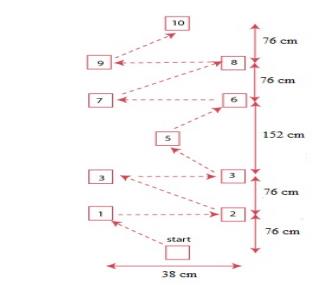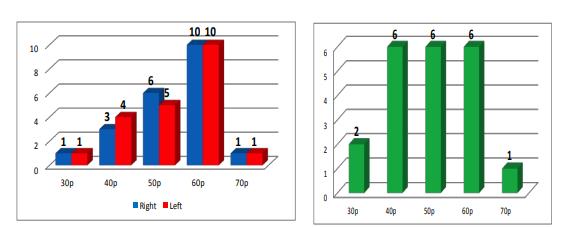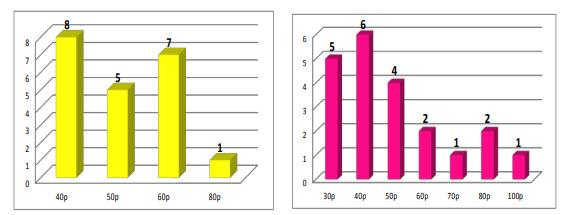Abstract
This paper aims to determine the initial level of static and dynamic balance, with a major contribution to achieving the athletic performance. The main objective is to assess balance in 9-10 years old gymnasts. Dynamic balance determines the performance in the flight phase and is specific to women’s artistic gymnastics at balance beam. Static balance is used to maintain the landing. For the dynamic balance, to determine its expression level, there were used the Bass and Matorin tests, and for the static balance, the Flamingo test and the test of maintaining the landing position on the balance board, with the eyes closed. The study was conducted in September-October 2014, during training in the following sports club gyms: CSS3 Steaua Bucharest, CSS2 Bucharest and Dinamo Bucharest. The study subjects were 21 junior III gymnasts aged 9-10 years old, registered at the three sports clubs from Bucharest. The research methods used were: bibliographical study, observation, statistical and mathematical method, graphical representation. The obtained results are the following: Matorin Test - for the right-turning jump, the mean was 315 degrees, and for the left-turning, 305 degrees; Flamingo test - the mean was 11.43 imbalances; the mean for the Bass Test was 60.24 points; at the test of maintaining the landing position, the mean was 26.05 seconds. After calculating the coefficient of variation, there is highlighted that the homogeneity of the group is moderate at the Matorin, Flamingo and Bass tests. At the test of maintaining the landing position, the group is not homogeneous.
Keywords: Artistic gymnastics, Matorin test, Flamingo test, Bass test, balance board
1. Introduction
Artistic Gymnastics is a sport that contributes to the development and improvement of motor and
psychomotor skills, and the education of volitional qualities. The level of development of these
qualities determines the performance in this sport. Balance is considered an essential component of
almost every motor performance task. Its function is regulated by the central nervous system based on
the afferent visual, tactile and proprioceptive impulses, as well as on information from the vestibular
system (McLeod & Hansen, 1989; Boswell, 1993; Ageberg, Zatterstrom, & Moritz, 1998; Kinzey &
Armstrong, 1998; quoted by Tsigilis, Zachopoulou, & Mavridis, 2001).
The gymnastic elements, by their structure, are claiming a highly developed sense of balance. In the
composition of the competition routine, we encounter manifestations of both static and dynamic
balance (Grigore, 2001: 45). Most sports are dynamic and require more appropriate measures of
dynamic balance, recording the ability to perform a task while maintaining or regaining a stable
position. Unlike static tests, there is a wide variety of dynamic balance tests and little agreement on
which are most appropriate. Definitions of dynamic balance vary and include: the ability to transfer the
vertical projection of the centre of gravity around the supporting base (Goldie et al. ,1989); the ability
to maintain steadiness following a perturbation of the support surface (Shultz et al., 2000); a
perturbation of the participant (Hoffman, Schrade, & Koceja, 1999); or requesting the participant to
maintain his or her balance following a change in position (Riemann et al., 1999) (quoted by Heller,
Senior, & Wheat, 2014).
Static balance entails the maintaining of landings, and dynamic balance determines the performance
in the flight phase. Due to the interaction of muscles, joints, breathing movements, heart rate while
maintaining the body balance, static balance becomes complicated dynamic balance. To restore the
muscular balance, it has to intervene with muscular strength. In the case of dynamic balance, body
restoring does not refer to bringing it in the optimal area, but its movement together with the supporting
surface (Grigore, 2001: 77-78). In Women’s Artistic Gymnastics, the beam can be characterized by
excellence as an apparatus of balance, because of its dimensions (L = 5 m, l = 10cm, h = 1.20 m). From
the biomechanical point of view, mastering and adjusting the balance during the beam routine can be
made respecting the law-like principle of permanent projection of the GCG on the supporting surface
(Vieru, 1997: 152).
The issue of balance was investigated in various sports such as: rhythmic gymnastics (Fotiadou et
al., 2002, 2009; Fotios et al., 2013), football, basketball, gymnastics (Bressel et al., 2007), and dance
(Strešková & Chren, 2009; Fotios et al., 2013). All this research was carried out in the laboratory using
the balance platform.
is to determine the initial level of the two types of balance (static and
dynamic), with a major contribution to achieving the athletic performance. is to
assess the balance in 9-10 years old gymnasts.
2. Materials and methods
2.1.Place and subjects
The study was conducted in September-October 2014, during training in the gyms of the following
sport clubs: CSS3 Steaua Bucharest, Dinamo Bucharest and CSS2 Bucharest. The study subjects were
21 junior III gymnasts aged 9-10 years old, registered at the three sports clubs from Bucharest.
2.2.Methods
The research methods used were: bibliographical study, observation method, statistical and
mathematical method, and graphical representation. For the dynamic balance, in order to determine its
expression level, there were used the Matorin and Bass tests, and for the static balance, there were used
the Flamingo test and the test of maintaining the landing position on the balance board, with the eyes
closed.
2.2.1. Test description
- From the standing position, the feet inside a circle with a diameter of 40 cm, it is
executed a straight jump around the longitudinal axis of the body, to the left and to the right. The jump
should measure as many degrees as possible, and the landing is made with the feet together, as in the
initial position. The athletes performed two jumps towards each direction, and the best performance
was recorded. It is measured the return angle (Cojocaru et al., 2011: 19-20).
- From the standing position on the preferred foot oriented to the longitudinal axis of
a balance support (dimensions: 50 centimetres long, 4 centimetres high and 3 centimetres wide), the
other leg is flexed at the knee level and the ankle is caught with the same side hand, and the other arm
is stretched forward. The subject must maintain this position for 1 minute. The gymnasts execute the
test one single time and it is recorded the total number of imbalances (Marcu, Chiriac, & Stan, 2009:
190).
Maintaining the landing position on the balance board - The subject is in the landing position on the
balance board, blindfolded. He must maintain this position as long as possible without touching the
ground with the balance board edges. The gymnasts execute the test once, and it is timed the duration
of maintaining the landing position.
(Fig. 1.) - The subject began by standing stationary on the right foot on the starting point
square. The subject then hopped to the first tape mark with the left foot and immediately held a static
position for five seconds. After this time, he hopped to the second tape mark with the right food and
held a static position for another five seconds. This continued with alternate foot hopping and holding a
static position for five seconds at each point until the course was completed. At each point, the sole of
the foot must completely have covered each tape mark so that it could not be seen. Scoring: a
successful performance consisted of hopping to each tape mark without touching the floor with the heel
or any other part of the body, and holding a static position on each tape mark for five seconds without
exposing the tape mark. There was made an attempt to accommodate with the test, followed by
performing the test with the result recording. The points are awarded as follows: 5 points for each
correct coverage of a landing mark, plus 1 point for every second of maintaining the balance. The
maximum score that can be reached is 10 points for each mark or 100 points for the entire route
(Nakhostin-Roohi, Hedayati, & Aghayari, 2013).

2.2.2. Procedure
After obtaining the results of the four tests, there were calculated the statistical indicators. With the
arithmetic mean and the standard deviation, it was performed the gymnast hierarchy for each test,
giving points as follows:
Arithmetic mean = 50 points; Arithmetic mean ± standard deviation = 50 points ± 10 points; Arithmetic mean ± 2 standard deviations = 50 points ± 20 points; Arithmetic mean ± 5 standard deviations = 50 points ± 50 points.
3.Results
Table 1 presents the results obtained by each athlete at the two tests used to determine the
expression level of dynamic balance (Matorin and Bass tests). Also, the following statistical indicators
were calculated: arithmetic mean, standard deviation and coefficient of variation.
Table 2 presents the results obtained by each athlete at the two tests used to determine the
expression level of static balance (Flamingo test and Maintaining the landing position on the balance
board, with the eyes closed). The same statistical indicators were calculated as in Table 1.
Figures 2 and 3 show the frequency of obtaining each score in a hierarchical order, for each test:
Matorin (Fig. 2a), Bass (Fig. 2b), Flamingo (Fig. 3a) and Maintaining the landing position on the
balance board, with the eyes closed (Fig. 3b). For the test of maintaining the landing position on the
balance board, with the eyes closed, in order to make the calibration, at the calculation of arithmetic
mean and standard deviation, there were removed the visible extremes. The following results were
obtained: arithmetic mean – 26 seconds, and standard deviation – 12.82 seconds.


4. Discussions and conclusions
The study, conducted on 21 gymnasts aged 9-10 years, primarily aimed at optimizing physical
training on balance.
Analysing the gymnasts’ results obtained in each test, we see that there is a big difference between
the best and the worst result, as follows:
At the Matorin test, for the jump with turn to the right, the best result was 4000, and the worst result
was 2100. To the left, the best result was 4500, and the worst result was 1800;
At the Bass test, the best result was 85 points, respectively 35 points; At the Flamingo test, 4 imbalances was the best result. The worst result was 15 imbalances; At the test of maintaining the landing position on the balance board, with the eyes closed, 99
seconds, respectively 0 seconds.
After calculating the coefficient of variation, it is highlighted that the group homogeneity is
moderate at the Matorin, Flamingo and Bass tests, and for the test of maintaining the landing position
on the balance board, the group is not homogeneous.
Looking at the gymnast ranking, the highest score was obtained by the athlete I.C., with a total of
320 points. The lowest score was recorded by P.N., 190 Points.
In performance sports, in order to have good results, it is required that the results of the gymnasts
have at least two standard deviations above average. From the group of 21 athletes, only one gymnast
had 2 deviations above average at the Matorin and Bass tests, a gymnast had three standard deviations
above average at the Flamingo test, and at the test of maintaining the landing position on the balance
board, with the eyes closed, four gymnasts recorded 2 standard deviations above average.
In conclusion, the training should be geared towards developing and improving balance. As the
results of the athletes are weak, the preparation will last longer.
Acknowledgements
This paper is made and published under the aegis of the National University of Physical Education and Sports from Bucharest, as a partner of program co-funded by the European Social Fund within the Operational Sectoral Program for Human Resources Development 2007-2013 through the project Pluri- and interdisciplinarity in doctoral and post-doctoral programs, Project Code: POSDRU/159/1.5/S/141086, its main beneficiary being the Research Institute for Quality of Life, Romanian Academy.
References
Bressel, E., Yonker, J., Kras, J., & Heath, E. (2007). Comparison of static and dynamic balance in female
collegiate soccer, basketball and gymnastics athletes. Journal of Athletic Training, 42(1), 42-46.
Cojocaru, V., Crețu, A., Șerbănoiu, S., Stănescu, M., Tudor, V., … & Angelescu, N. (2011). Evaluarea
potențialului somatic, funcțional și motric al populației școlare din România. UNEFS, București.
Fotiadou, E., Giagazoglou, P., Kokaridas, D., Angelopoulou, N., Tsimaras, V., & Tsorbatzoudis, C. (2002).
Effect of rhythmic gymnastics on the dynamic balance of children with deafness. European Journal of Special Needs Education, 17(3), 301-309.
Fotiadou, E., Neofotistou, K., Sidiropoulou, M., Tsimaras, V., Mandroukas, A., & Angelopoulou, N. (2009).
The effect of a rhythmic gymnastics program on the dynamic balance ability of individuals with intellectual disability. Journal of Strength and Conditioning Research, 23(7), 2102-2106.
Fotios, M., Miltiadis, P., Eirini, A., & Andromahi, S. (2013). Dynamic balance in girls practicing recreational rhythmic gymnastics and Greek traditional dances. Science of Gymnastics Journal, 5(1), 61-70.
Grigore, V. (2001). Gimnastica artistică – Bazele teoretice ale antrenamentului sportiv. București: Semne.
Heller, B., Senior, T., & Wheat, J. (2014). The Smartfloor: A large area force-measuring floor for investigating dynamic balance and motivating exercise. Procedia Engineering, 72, 226-231.
Marcu, V., Chiriac, M., & Stan, Z. (2009). Studii și cercetări privind evaluarea în cultură fizică și sport. Oradea: Editura Universității din Oradea.
Nakhostin-Roohi, B., Hedayati, S., & Aghayari, A. (2013). The effect of flexible flat-footedness on selected physical fitness factors in female students aged 14 to 17 years. Journal of Human Sport & Exercise, 8(3), 788-796.
Strešková, E., & Chren, M. (2009). Balance ability level and sport performance in Latin-American dances. Facta Universitatis Physical Education and Sport, 7(1), 91-99.
Tsigilis, N., Zachopoulou, E., & Mavridis, T. (2001). Evaluation of the specificity of selected dynamic balance tests. Perceptual and Motor Skills, 92(3 Pt 1), 827-833.
Vieru, N. (1997). Manual de gimnastică sportivă. București: Driada.
Copyright information

This work is licensed under a Creative Commons Attribution-NonCommercial-NoDerivatives 4.0 International License.
About this article
Publication Date
10 June 2016
Article Doi
eBook ISBN
978-1-80296-010-5
Publisher
Future Academy
Volume
11
Print ISBN (optional)
-
Edition Number
1st Edition
Pages
1-509
Subjects
Sports, sport science, physical education
Cite this article as:
Gavojdea, A. (2016). Study Regarding Balance in 9-10 Years Old Gymnasts. In V. Grigore, M. Stanescu, & M. Paunescu (Eds.), Physical Education, Sport and Kinetotherapy - ICPESK 2015, vol 11. European Proceedings of Social and Behavioural Sciences (pp. 218-225). Future Academy. https://doi.org/10.15405/epsbs.2016.06.30

